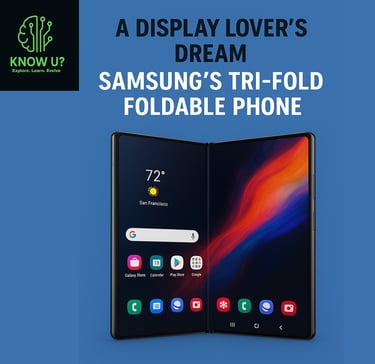A Display Lover’s Dream: Samsung’s Tri-Fold Foldable Phone
If you’re a fan of big screens and sleek smartphones, the rumored Samsung tri-fold foldable might feel like the holy grail of devices.
10/19/20252 min read


A Display Lover’s Dream: Samsung’s Tri-Fold Foldable Phone
If you’re a fan of big screens and sleek smartphones, the rumored Samsung tri-fold foldable might feel like the holy grail of devices. The upcoming rumored handset — often referred to as the Galaxy Z Tri‑Fold — is shaping up to bring a tablet-sized display into a pocketable form. And while that’s enormously exciting for anyone who craves expansive screen real estate, the device’s success all hinges on one critical component: the hinge mechanism.
Why the Display Factor Is So Compelling
Let’s start with the screen: according to leaks, when unfolded, the Galaxy Z Tri-Fold could offer around a 10-inch display, bringing a near-tablet-level canvas to your phone. inkl+2FindArticles+2 For content streaming, multitasking, gaming, or simply browsing, that kind of size is a major step up from current foldables. If you’re a display lover looking for that “wow” factor, this could be it.
The Hinge: The Feature That Makes or Breaks It
As compelling as the large display is, all that flexibility introduces one big risk: durability. Foldables are inherently more complex — they have moving parts, hinges, multiple panels — and the more folds you add, the more potential points of failure. This tri-fold design reportedly uses two hinges, which means double the mechanical stress and double the risk. inkl+1
Past models in Samsung’s foldable lineup (and other brands) have had hinge-related issues: visible creases, dust ingress, and hinge wear over time. Add a second hinge, and you really raise the stakes. If Samsung wants to deliver a foldable phone that’s not just flashy but durable, the hinge design is where the rubber meets the road.
What Samsung Needs to Get Right
Here are a few of the hinge/display-related challenges that the Galaxy Z Tri-Fold (and any tri-fold phone) will need to solve:
Dust and debris protection: A hinge gap is a natural place for particles to enter, which can cause wear, screen lifting, or hinge failure over time. Reports highlight that Samsung’s recent foldables only carry an IP48 rating, meaning fine dust could still pose a risk. Yahoo Tech+1
Crease minimization and display integrity: With more folds, you want to avoid obvious creases or weak points in the display that might degrade the viewing experience or reduce lifespan.
Structural thickness & weight: Adding an extra hinge and panel risks making the phone too thick or heavy when folded. The trick is preserving portability while unlocking that large screen.
Battery and thermal management: A large display and two hinges imply more power draw, more moving parts, and potentially more heat. Rumours even mention three separate battery cells to balance capacity and design. Tom's Guide+1
Should You Be Excited? Yes—but With Caution
If everything comes together — if Samsung nails the hinge design, keeps the phone reasonably slim, and ensures the display performs well — then this tri-fold concept could be an excellent fit for tech enthusiasts, multitaskers, and “display lovers” who want more from their phone than a typical slab.
Explore
Stay updated with the latest tech trends.
Contact us
Discover
© 2025. All rights reserved.
Terms & Conditions
Welcome to KnowUtech (accessible at https://www.knowutech.blog). By accessing or using our website, you agree to follow the terms and conditions stated below. Please read them carefully.
1. Use of Our Website
The content on this website is provided for general information and educational purposes only.
You agree not to use this site for any unlawful purpose or in a way that may damage or interfere with the site.
2. Intellectual Property
All articles, images, graphics, and content published on KnowUtech are owned by us or licensed for use.
You may not copy, reproduce, or republish content without prior written consent.
3. External Links
Our blog may contain links to third-party websites. We are not responsible for the content, accuracy, or practices of these external sites. Visiting external links is at your own risk.
4. Limitation of Liability
While we aim to provide accurate and up-to-date information, KnowUtech makes no warranties about completeness or reliability.
We are not liable for any losses, damages, or issues arising from using our site.
5. Changes to Terms
We may update or modify these Terms at any time without prior notice.
Continued use of the site means you accept the updated Terms.
6. Contact Us
If you have questions about these Terms, please contact us at:
📧 knowu0082@gmail.com
Privacy Policies
At KnowUtech, your privacy matters to us. This Privacy Policy explains how we collect, use, and safeguard your information when you visit our website https://www.knowutech.blog.
1. Information We Collect
Personal Information: When you voluntarily subscribe, comment, or contact us, we may collect your name and email address.
Non-Personal Information: We may collect technical details such as browser type, device information, and pages visited for analytics purposes.
2. Use of Information
We use the collected data to:
Improve our website content and user experience.
Respond to your inquiries or comments.
Send occasional updates or newsletters (only if you opt in).
3. Cookies
Our site may use cookies to enhance browsing and analyze traffic.
You can disable cookies in your browser settings if you prefer.
4. Third-Party Services
We may use third-party tools such as Google Analytics or advertising networks (e.g., Google AdSense) that collect information to provide personalized ads and improve services.
These third parties follow their own privacy policies.
5. Data Protection
We do not sell or trade your personal information to outside parties.
Reasonable security measures are applied to protect data, though no method is 100% secure.
6. Your Rights
You can request correction or deletion of your personal data by contacting us.
You may also opt out of newsletters at any time.
7. Updates to This Policy
We may update this Privacy Policy from time to time. Any changes will be posted on this page with the revised date.
